The following article was sourced from a Wikipedia page at the following address: http://en.wikipedia.org/wiki/Dress
DRESSES
A dress (also known as a frock or a gown) is a garment consisting of a skirt with an attached bodice (or a matching bodice giving the effect of a one-piece garment). In Western culture, dresses are usually considered to be items of women's and girls' apparel.
The hemlines of dresses vary depending on the whims of fashion and the modesty or personal taste of the wearer.

A typical pre-prom gathering, with girls in dresses, and boys in tuxedos
TYPES OF DRESSES

Ball gown, a very formal dress, typically elaborate and floor-length

Bouffant gown, a fancy gown for formal occasions

Cocktail dress, a semi-formal dress

Débutante dress, a white dress worn by young women at debutante cotillions
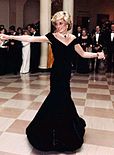
Evening gown, a long dress worn for evening events
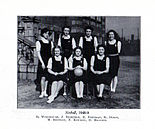
Gymslip, a sleeveless tunic most commonly worn as part of a girl's school uniform

House dress, an informal dress worn at home for doing housework in

Jumper dress, a dress worn over a blouse

Little black dress, an evening dress or cocktail dress, often quite short, which has enjoyed popularity as a wardrobe staple since the 1920s
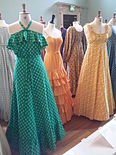
Maxi dress, a long dress, often ankle length, corresponding to the maxi skirt
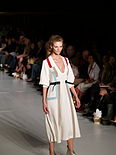
Midi dress, a dress of mid-calf length

Minidress, a short dress with a high hemline equivalent to that found on a mini skirt

Nightdress, worn as nightwear, which may come in a variety of styles
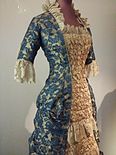
Princess dress, a fitted dress shaped by long shaped panels and seams rather than by darts

Sailor dress, a dress with sailor collar and styling. Also known as a Peter Thomson dress

Sari, a style of clothing worn by women in the Indian Subcontinent
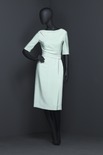
Sheath dress, a form fitting (or sheath-like) dress

Shift dress or chemise, a short, sleeveless dress in a simple style with little detailing
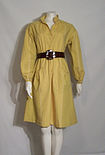
Shirtdress, a dress borrowing details from the style of a men's shirt, often including collar or front buttons

Slip dress, a dress closely resembling a petticoat

Strapless dress, a dress with no visible means of support (usually held up by interior corsetry or boning, or by elasticated fabric)
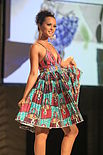
Sundress, intended for wearing in warmer weather. It will often be made of a lightweight fabric and will frequently be sleeveless

Tea gown, a semiformal gown intended for wear during afternoon tea

Trapeze dress, an exaggerated A-line dress flaring from a fitted shoulder
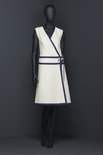
Wrap dress, a dress having a front closure which wraps around the body, forming a v-shaped neckline
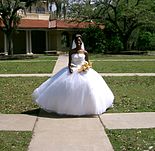
There are numerous styles of wedding dress worn exclusively by the bride at her wedding. In Western cultures, white is the most popular colour

Traditional Japanese kimono-style wedding dress

Rajput bride (India) wearing pink
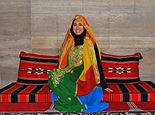
Traditional Bahrain wedding dress
LENGTHS OF DRESSES AND SKIRTS
Mini skirt
A miniskirt (sometimes hyphenated as "mini-skirt") is a skirt with a hemline well above the knees, generally at mid-thigh level, normally no longer than 10 cm (4 in) below the buttocks; and a minidress is a dress with such a hemline. A micro-miniskirt or microskirt is a miniskirt with its hemline at the upper thigh, at or just below crotch level.
The popularity of miniskirts peaked in the "Swinging London" of the 1960s, but it is still commonplace among many women, especially teenagers, preteens, and young adults. Before that time, short skirts were only seen in sport and dance clothing, such as skirts worn by female tennis players, figure skaters, cheerleaders, and dancers. Read More…
Tea length
A tea gown or tea-gown is a woman's at-home dress for informal entertaining which became popular around the mid 19th century characterized by unstructured lines and light fabrics. Early tea gowns were a European development influenced by Asian clothing and historical approach from the 18th century which led to the renaissance time period of long and flowing sleeves. Part of this European sense of fashion came from the Japanese Kimono as they were worn by Japanese women during a wedding or any formal ceremonies.
Tea gowns were intended to be worn without a corset or assistance from the maid; however, elegance always came first.
During the 19th century, it was not appropriate for women to be seen in public wearing a tea gown. They were intended to be worn indoors with family and close friends during a dinner party.
Although tea gowns were meant for midday wear, they could be worn into the evening. Women started wearing tea gowns in the evening for dinner or certain events at home with close friends and family by 1900. Tea gowns intended for day wear usually had high necks, while evening tea gowns had lower necks. Read more...
Ballerina length
A tutu is a skirt worn as a costume in a ballet performance, often with attached bodice. It consists of a basque (or waistband, as it can either be part of the bodice or a separate band) and the skirt itself might be single layer, hanging down, or multiple layers starched and jutting out. The bell-shaped Romantic dress of the mid-1800s gave way to the tutu at the end of the 19th century. Connoisseurs of ballet, the Russians wanted to see the new technical feats and fancy footwork of their ballerinas. The new long, floppy, 16 layer tutus reached to the knee and allowed the female dancers much greater mobility in such technically demanding ballets as Swan Lake, The Sleeping Beauty, and Paquita. Read more…
Midi / Maxi skirt
A skirt is a tube- or cone-shaped garment that hangs from the waist or hips and covers all or part of the legs. The hemline of skirts can vary from micro to floor-length and can vary according to cultural conceptions of modesty and aesthetics as well as the wearer's personal taste, which can be influenced by such factors as fashion and social context. Most skirts are self-standing garments, but some skirt-looking panels may be part of another garment such as leggings, shorts and swimsuits.
In the western world, skirts are considered women's clothing; with some exceptions such as the izaar which is worn by Muslim cultures and the kilt which is a traditional men's garment in Scotland and Ireland. Some fashion designers, such as Jean-Paul Gaultier, have shown men's skirts. The whirling dervishes and other cultures traditionally wear skirts.
At its simplest, a skirt can be a draped garment made out of a single piece of material (such as pareos), but most skirts are fitted to the body at the waist or hips and fuller below, with the fullness introduced by means of darts, gores, pleats, or panels. Modern skirts are usually made of light to mid-weight fabrics, such as denim, jersey, worsted, or poplin. Skirts of thin or clingy fabrics are often worn with slips to make the material of the skirt drape better and for modesty. Read more…
For more information re dresses, please click on the following link: http://en.wikipedia.org/wiki/Dress
